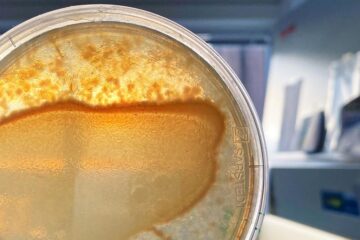New Recombinant Production of Design Rhamnolipids – Optimized Biosurfactant Fermentation Process

Biosurfactants have attracted increasing interest since they show a number of advantages over surfactants of petrochemical origin in terms of ecological acceptance, low toxicity and sustainability. Biosurfactants also have a huge application potential, for example in chemical and pharmaceutical industry or as emulsifier in cosmetics and foods.
Among the best established biosurfactants are the rhamnolipids. Rhamnolipids are glycosides with one (mono-rhamnolipid) or two rhamnose-units (di-rhamno-lipid) as the glycon portion and one to three β-hydroxy-fatty acid moieties as the aglycon portion. Rhamnolipids are naturally produced by two rhamnosyl-transferases encoded by rhlA, rhlB and rhlC by the opportunistic pathogen Pseudomonas aeruginosa. The rhlA and rhlB genes form an operon, encoding subunits A and B of rhamnosyltransferase 1, while rhlC encodes rhamnosyltransferase 2. In particular, the present invention provides a genetically modified non-pathogenic host cell that may be employed for production of favoured rhamnolipids in high yields. Use of the modified host cell allows selective production of various rhamnolipids, e.g. mono- or dirhamnolipids and a various length of fatty acids. As a first example, a bacterial host cell includes a rhlA gene, a rhlB gene or orthologs thereof. The genes are under the control of a heterologous promoter. In a further embodiment, the host cell may preferably also contain a rhlC gene, or an ortholog thereof. The biotechnical production process is in addition optimized at varying temperature conditions.
Weitere Informationen: PDF
PROvendis GmbH
Tel.: +49 (0)208/94105 10
Ansprechpartner
Dipl.-Ing. Alfred Schillert
Media Contact
Alle Nachrichten aus der Kategorie: Technologieangebote
Neueste Beiträge

Das Mikrobiom verändert sich dynamisch und begünstigt wichtige Funktionen für den Wirt
Ein interdisziplinäres Forschungsteam des Kieler SFB 1182 untersucht am Beispiel von Fadenwürmern, welche Prozesse die Zusammensetzung des Mikrobioms in Wirtslebewesen steuern. Alle vielzelligen Lebewesen – von den einfachsten tierischen und…

Wasser im Boden – genaue Daten für Landwirtschaft und Klimaforschung
Die PTB präsentiert auf der Woche der Umwelt, wie sich die Bodenfeuchte mithilfe von Neutronenstrahlung messen lässt. Die Bodenfeuchte hat nicht nur Auswirkungen auf die Landwirtschaft, sondern ist als Teil…

Bioreaktor- und Kryotechnologien für bessere Wirkstofftests mit humanen Zellkulturen
Medizinische Wirkstoffforschung… Viele Neuentwicklungen von medizinischen Wirkstoffen scheitern, weil trotz erfolgreicher Labortests mit Zellkulturen starke Nebenwirkungen bei Probanden auftreten. Dies kann passieren, wenn zum Beispiel die verwendeten Zellen aus tierischem…

















